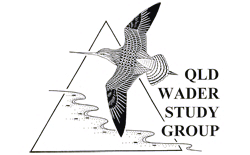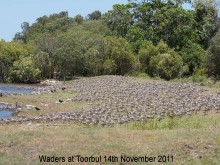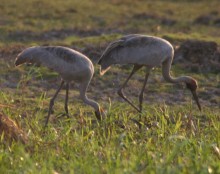Site information:
Located on the western side of Pumicestone Passage with Bribie Island to the east, the four roost sites along the Esplanade at Toorbul support large numbers of waders that feed on the huge expanse of intertidal mudflats in the passage. These roost sites are all close enough to the road to provide good views with binoculars. It is advisable to visit these sites on a high tide of 2 m or less, as higher tides force the waders onto less accessible roost sites elsewhere in the passage. The Esplanade is an excellent place to view waders feeding on incoming and outgoing tides. A highlight of this stretch of the coastline is Red Knot, commonly seen between September and November, when large numbers are passing through on migration to New Zealand and more southerly parts of Australia. Less regularly observed species such as Broad-billed Sandpiper, Double-banded Plover, Grey Plover and Asian Dowitcher, have been recorded here.
The first roost site, commonly known as Pelican Point, is 1.1 km south of the Toorbul general store. Display boards erected by the Caboolture Branch of the Wildlife Preservation Society of Queensland illustrate some of the different species that are regularly seen at this site, such as Bar-tailed Godwit, Common Greenshank and Great Knot. Sharp-tailed Sandpiper is sometimes seen in the adjoining samphire.
Another 0.7 km south of Pelican Point is Sandfly Bay, a small bay with mangroves at each end. Waders tend to roost at this site if there is disturbance at the other sites, although this is the most likely spot where Grey Plover will be seen. Another 200 m south of Sandfly Bay is the main Toorbul roost site. This is a popular wader-watching spot, providing close views of many different species. Sooty Oystercatcher, listed as rare in Queensland, are sometimes seen here and appear to alternate between this site and Kakadu Beach on Bribie Island (see section 9.6.5).
A smaller roost is situated at the northern end of The Esplanade. To reach this site, return along The Esplanade until reaching Carnegie Street, 0.8 km past Toorbul Store & Tavern. The sandbank opposite this street is used by a range of species including Pacific Golden Plover, a species rarely recorded at the other sites.
Before heading home, it is worth stopping at Bishop’s Marsh, located on the southern side of the connection road to the Bruce Highway, a distance of 6.0 km from the Toorbul Store & Tavern. Depending on recent weather conditions, water levels vary considerably and this wetland may disappear in periods of drought. This site supports a range of waterbirds and some waders, such as Marsh Sandpiper, Sharp-tailed Sandpiper, Black-winged Stilt and Black-fronted Dotterel. Brolga are regularly seen in and around the wetland and neighbouring paddocks. Black-necked Stork and Latham’s Snipe are less common visitors.
How to get there: The township of Toorbul is situated about 63 km north of Brisbane and is reached via the Bruce Highway. About 49 km from Brisbane, take the Toorbul/Donnybrook exit, drive across the bridge over the highway and head east. Continue along this road for 14 km until reaching a T-junction. At this intersection, turn left and in a short distance there is another T-junction, which is the intersection with The Esplanade. The Toorbul Store & Tavern is located on the corner. Be vigilant when driving along The Esplanade, as relatively tame kangaroos frequent the grassed areas by the side of the road and may stray into your path.
Amenities/access: A range of take-away food can be bought at the Toorbul Store & Tavern. Toilets and outdoor showers to wash the sand from your feet are located opposite this store. Picnic and barbeque facilities are located at several places along The Esplanade. All roost sites are easily accessible for disabled people. Caravan and camping sites are available in the council caravan park located off The Esplanade just north of the Toorbul Store & Tavern, where bookings can be made.
Site coordinates:
Pelican Point: Lat 27º 02’ 40” S, Long 153º 06’ 22” E
Sandfly Bay: Lat 27º 02’ 41” S, Long 153º 06’ 42” E
Main Toorbul roost: Lat 27º 02’ 52” S, Long 153º 06’ 50” E
Toorbul North Sandspit: Lat 27º 01’ 63” S, Long 153º 05’ 58” E
Bishop’s Marsh: Lat 27º 02’ 08” S, Long 153º 03’ 16” E.
Wader species: Toorbul: Bar-tailed Godwit, Black-tailed Godwit, Whimbrel, Eastern Curlew, Common Greenshank, Terek Sandpiper, Broad-billed Sandpiper, Grey-tailed Tattler, Ruddy Turnstone, Asian Dowitcher, Great Knot, Red Knot (September – December), Red-necked Stint, Sharp-tailed Sandpiper, Curlew Sandpiper, Latham’s Snipe, Pied Oystercatcher, Sooty Oystercatcher, Black-winged Stilt, Pacific Golden Plover, Grey Plover, Red-capped Plover, Double-banded Plover (March – August), Lesser Sand Plover, Greater Sand Plover and Masked Lapwing. Bishop’s Marsh: Marsh Sandpiper, Sharp-tailed Sandpiper, Black-winged Stilt, Black-fronted Dotterel and Masked Lapwing.
Other species: Toorbul: Striated Heron, Royal Spoonbill, Gull-billed Tern, Caspian Tern and Little Tern. Bishop’s Marsh: Brolga and Black-necked Stork.


